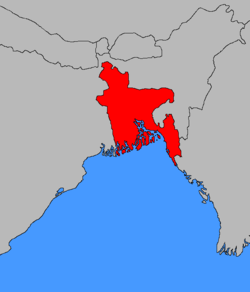History of Bangladesh (1947-1971)
| East Pakistan পূর্ব পাকিস্তান |
|||||
| Subdivision of Pakistan | |||||
|
|||||
|
Flag |
|||||
| Map of Pakistan with East Pakistan highlighted | |||||
| Capital | Dacca | ||||
| History | |||||
| • | Established | 23 March 1956 | |||
| • | Disestablished | 16 December 1971 | |||
| Area | 147,610 km2(56,993 sq mi) | ||||
| Today part of | Bangladesh | ||||
Flag
The history of East Pakistan from 1947 to 1971 covers the period of Bangladesh's history between its independence as a part of Pakistan from British colonial rule in 1947 to its independence from Pakistan in 1971.
After British left India two sovereign countries were created: India and Pakistan. Pakistan comprised as East Pakistan and West Pakistan. Pakistan was born in bloodshed and came into existence on August 14, 1947, confronted by seemingly insurmountable problems. Pakistan's boundaries were established hastily without adequate regard for the new nation's economic viability. Until 1947, the East Wing of Pakistan, separated from the West Wing by 1,600 kilometres (990 mi) of Indian territory, had been heavily dependent on Hindu management. Many Hindu Bengalis left for Calcutta after partition.
After partition, Muslim banking shifted from Bombay to Karachi, Pakistan's first capital. Much of the investment in East Pakistan came from West Pakistani banks. The largest jute processing factory in the world, at Narayanganj, an industrial suburb of Dhaka, was owned by the Adamjee family from West Pakistan. Because banking and financing were generally controlled by West Pakistanis, discriminatory practices often resulted. This preference became more pronounced after explosive labor clashes between the Biharis and Bengalis at the Narayaganj jute mill in 1954.
Pakistan had a severe shortage of trained administrative personnel, as most members of the pre-independence Indian Civil Service were Hindus or Sikhs who opted to belong to India at partition. Rarer still were Muslim Bengalis who had any past administrative experience. As a result, high-level posts in Dhaka, including that of governor general, were usually filled by West Pakistanis or by refugees from India who had adopted Pakistani citizenship.
...
Wikipedia


